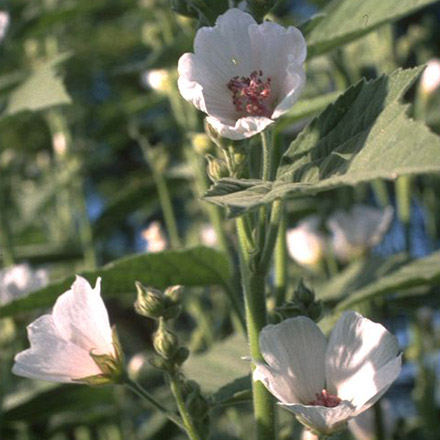Botanical name
Althaea officinalis L.
Family
Malvaceae
Common name
Marshmallow, Common mallow, White mallow, Sweet weed, Mallards
Information about the plant
Marshmallow is native to Asia and is now widespread westwards to southeastern Europe, and eastwards through Central Asia to China, often also growing wild as a garden plant. The genus name Althaea is derived from the Greek 'altheeis' (= medicinal). The species epithet officinalis suggests that it is an old medicinal plant because the ‘officina’ is the pharmacy salesroom, and 'officinalis' means ‘commonly used in the pharmacy’.
The marshmallow grows up to 1.50 m high and has velvety, hairy, 3 to 5-lobed leaves with palmate venation. Large white to pink flowers grow in the leaf axils. Strong, gray-brown roots up to 50 cm long run downwards from a short rhizome. It flowers from July to September.
Medicinally used parts of plants (herbal drug)
The peeled or unpeeled roots (marshmallow root - Althaeae radix) and the leaves (marshmallow leaves - Althaeae folium) are used. Peeling the root is very time-consuming, and not really justified in terms of content, but it is an old traditional practice. The root drug is always commercialized peeled and in a typical cube shape, and comes from cultivations in Bulgaria, the former Yugoslavia, Russia, Hungary, and Belgium. The leaf drug, which is a by-product of the root harvest, is also from these countries.
Constituents of the herbal drug
Marshmallow root and marshmallow leaves contain mucilage.
Quality of the drug
The quality of the following drugs or drug preparations is specified in the European Pharmacopoeia (Ph. Eur.):
- Marshmallow root (Althaeae radix)
- Marshmallow leaves (Althaeae folium)
Medical applications
Recognised medical use
Marshmallow root
The HMPC has classified marshmallow root as a traditional herbal medicinal product (see "Traditional use").
ESCOP: dry irritating cough; irritation of the oral and pharyngeal mucosa; for the relief of mild gastrointestinal discomfort and irritation of the gastric mucosa. These indications are based on human experience and long-standing use.
Traditional use
Marshmallow root has been classified by the HMPC as a traditional herbal medicinal product (Article 16a of Directive 2001/83/EC) for use in the specified indications exclusively based on long-standing use. Marshmallow root can be used as a demulcent preparation for the symptomatic treatment of oral or pharyngeal irritation and associated dry cough, and for the symptomatic relief of mild gastrointestinal discomfort.
Herbal drug preparations in finished dosage forms
Marshmallow root
- sliced marshmallow root for tea preparation
- powdered drug in tablets
- dry extracts in soluble instant teas
- aqueous extract in juice and syrup
- cut marshmallow leaves for tea preparation
Dosage
Finished medicinal products: see patient information leaflet.
Tea infusion: drink a cup of cold-prepared marshmallow infusion 3 times a day.
Daily dose:
- Marshmallow root: children 3.0 to 4.5 g, adolescents and adults 10 g.
- Marshmallow leaves: 5 g; a combination with other drugs, e.g. lime blossoms, ribwort plantain, mallow leaves (cold tea) is useful.
Preparation of a tea
Pour approx. 150 mL of cold water over 1 to 2 teaspoons (approx. 0.5 to 3 g) of sliced marshmallow root or 1 tablespoon (approx. 2 g) of cut marshmallow leaves and leave to stand for 1 to 2 hours, stirring occasionally. The tea is then briefly heated to boiling point, cooled again, and then passed through a tea strainer.
Notes
Diabetic patients must pay attention to the sugar content of marshmallow syrup on the packaging.
There are no safety studies on the use of marshmallow root during pregnancy and lactation.
The use in children under 3 years of age is not recommended as these symptoms should be treated by a doctor.
The use of marshmallow root for stomach complaints in children under 12 years of age is not recommended due to a lack of evidence.
Side effects
None known.
Interactions
Marshmallow root should be taken ½ to 1 hour before, or 2 hours after taking other medicines, as otherwise, the absorption of other medicines from the gastrointestinal tract may be delayed.
References
Herbal drug monographs
HMPC (2016), ESCOP (2019), WHO (Vol. 2, NIS)
Further literature
Commentary to the European Pharmacopoeia (Marshmallow root, Nr. 1126; Marshmallow leaves Nr. 1856)


